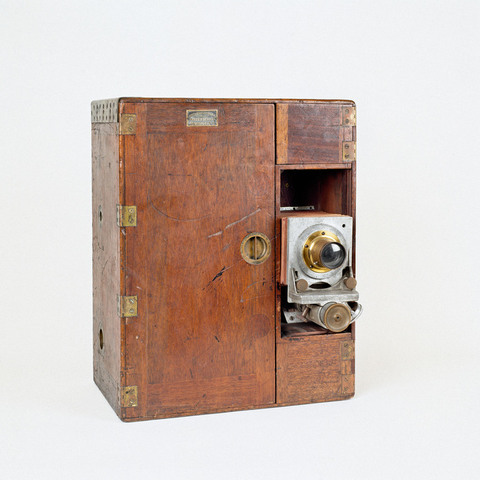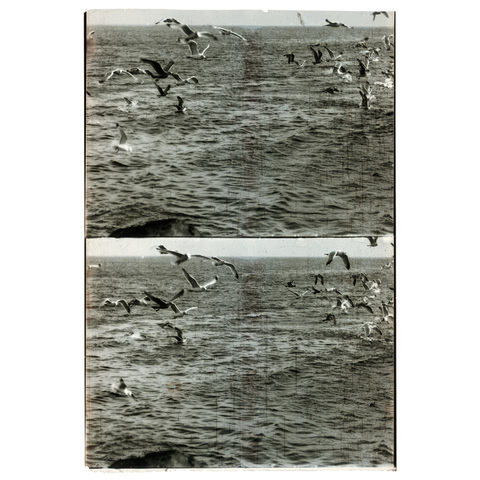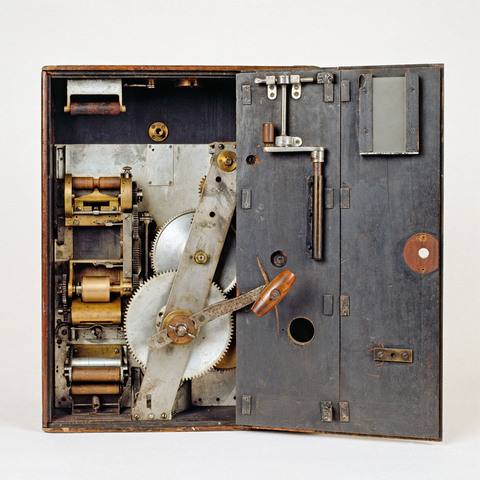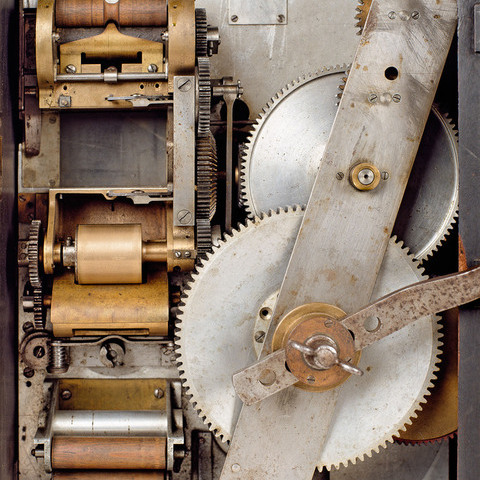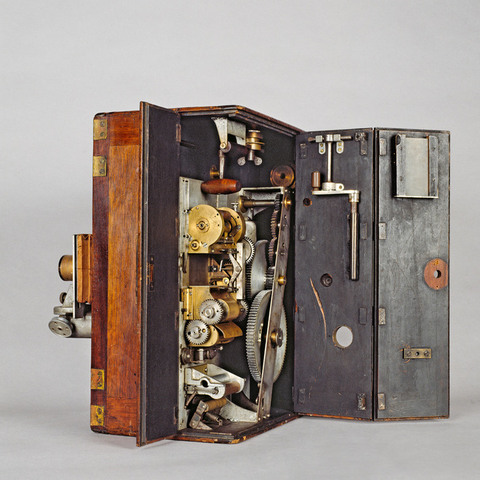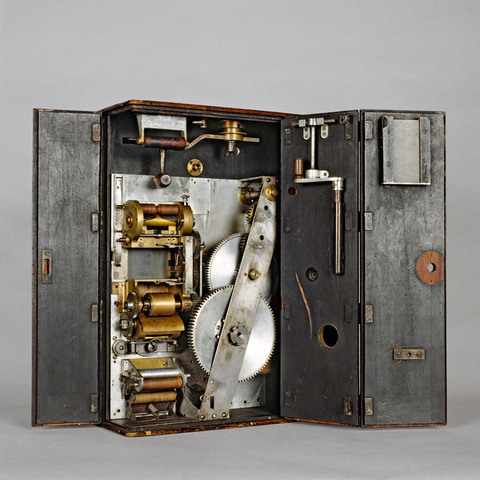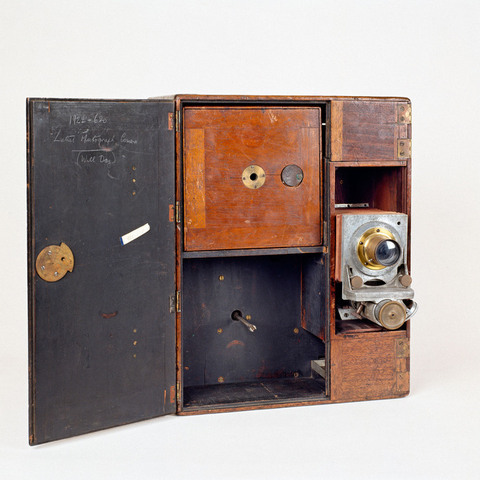Caméra film 68 mm
Fiche détaillée
Type de l'appareil
entraînement du film 68 mm par friction et rouleau demi évidé (genre Bouly) ; came excentrique ronde et bielle ; perforations (un trou rond de chaque côté de l'image) effectuées pendant la prise de vues par deux pointes métalliques ; obturateur réglable ; emplacement à l'avant de l'appareil pour deux magasins en bois ; magasin à noyau en bois ; joue métallique et six barres en laiton ; objectif à soufflet et crémaillère
Auteurs
Dickson William Kennedy Laurie
Canastota, New York
Koopman Elias Bernard
Canastota, New York
Casler Hermann
Syracuse, Country of Onondaga, State of New York
Fabricants
American Mutoscope and Biograph Company
New York, N.Y.
Utilisateurs
Dickson William Kennedy Laurie
Canastota, New York
Koopman Elias Bernard
Canastota, New York
Casler Hermann
Syracuse, Country of Onondaga, State of New York
Distributeurs
British Mutoscope and Biograph Company LTD
Londres
Sujet du modèle
Informations non disponibles
Objectif
Extra-Rapid Universal series D, 5 x 8, Bausch & Lomb Optical Company, New York - Rochester N.Y - Chicago n° 159 365
Taille de l'objet
Ouvert :
Informations non disponibles
Fermé :
Longueur : 35 cm
Largeur : 39 cm
Hauteur : 50 cm
Diamètre :
Informations non disponibles
Taille de la boîte de transport
Informations non disponibles
Remarques
Collection Will Day.
Etiquette métallique sur la porte frontale : "Designed and Built by Marvin & Casler, Canastota, N.Y."
Le magasin de cette caméra porte la mention manuscrite : " Pres. Kruger". Ce modèle pèse 110 pounds (près de 50 Kg).
Collection Will Day : "136. One Biograph Camera, being the third instrument to be produced which was also used for taking Mutograph pictures. Complete with lens and equipment in leather case for 2 1/4 inch film. 1898" (Will Day, Illustrated Catalogue of the Will Day Historical Collection of Cinematograph and Moving Picture Equipment, London, 1930, p. 22).
"Herman Casler (1867-1939) was the co-founder with Elias Koopman, Harry Marvin and W. K. L. Dickson, of the KMCD group, which eventually became the American Mutoscope and Biograph Company. Following an initial suggestion from Dickson, Casler developed the Mutoscope - a viewing device which used radially-mounted photographs flicked over in rapid sequence to give an illusion of movement. This instrument which was ready by the autumn of 1894, was originally intended to be a competitor to the Edison Kinetoscope. Casler next worked on the development of a camera, the Mutagraph, to provide subjects for it, and by June 1895 a prototype had been successfully tested with film. In the meantime, it had become clear that it was projected film rather than the Kinetoscope that offered the most potential for a long term business ; and Casler therefore designed the Biograph projector. Electrically driven, and using wide-gauge sprocketless film, it was intended, like the camera, to be as different as possible from anything that had been patented by Edison. Dickson's knowledge of the development work done at West Orange makes it very likely that he was involved with Casler, at least at the design stage, but officially it was Casler who was announced as the inventor in both patent specifications and theatre announcements. The high quality mechanical work done by both Casler and Marvin laid the foundation for the later success of the Biograph group. Both camera and projector produced outstandingly good results, competitors it faced. It was by using Casler's patents as security for loans that the group was able to raise the considerable amount of catpital required to begin international expansion during the 1890s" (Richard Brown, Stephen Herbert, "Herman Casler", Who's Who of Victorian Cinema, Edited by Stephen Herbert and Luke McKernan, London, BFI, 1996).
"Henry Norton (Harry) Marvin (c. 1863 - 1940). Harry Marvin, a college teacher, met W.K.L. Dickson in the 1880s, and in 1894 Dickson, then still working for Thomas Edison and also involved with the Lathams, proposed to Marvin a flip-card device that would compete with the Kinetoscope. Elias Koopman, Herman Casler, Marvin and Dickson called themselves the KMCD group to develop the idea, the Mutoscope viewer patent being applied for in November. Soon Casler had constructed a large-format camera, and the first test in June 1895, probably shot at the Syracuse engineering workshop of Casler's employer C.E. Lipe, showed Marvin and Casler in a mock sparring match. In June 1895 Harry Marvin obtained sufficient finance to open the Marvin Electric Rock Drill Works in Canastota, New York, for the manufacture of rock drills based on his patent. Casler was superintendent, and worked on his motion-picture experiments on the same site. [...] In December the group formed the American Mutoscope Company (later American Mutoscope and Biograph), which would become one the leading producers and exhibitors in the filed, with a British associate company. In December 1896 Edison successfully appealed against the Patent Office rejection of this (Edison's) camera patent, offering a new set of specifications. Harry Marvin claimed that the new specifications were for an entirely different invention, but this claim was thrown out on a technicality. Later, Marvin suggested that fraud had been involved. Discouraged by low profits and Biograph's comparative success, Edison contemplated selling his motion picture business to Biograph for $ 500 000. On 12 April 1900, Marvin paid Edison a $ 2500 option, but the deal fell through" ("Henry Norton (Harry) Marvin", Stephen Herbert, Who's Who of Victorian Cinema, Edited by Stephen Herbert and Luke McKernan, London, BFI, 1996).
"In 1895 Herman Casler, together with William Dickson, perfected the Mutograph camera, which used unperforated film. At the moment of exposure, the film was punched with two registration holes, one on each side of the frame. [...] The 35mm offspring of this ingenious camera was contructed in 1899, and the five or six cameras completed thereafter were used by cameraman Billy Bitzer to film many of D. W. Griffith's earliest productions" (D. Karl Malkames, "Centennial of the Biograph Motion Picture System", SMPTE Journal, Decembre 1999, p. 857-858).
"Durant l'été ou au début de l'automne 1894, William Kennedy Laurie Dickson qui travaillait avec Edison à diverses études depuis 1883 (selon Gordon Hendricks) et avait joué un rôle de premier plan dans la mise au point du Kinetoscope et le tournage des films, aurait suggéré à ses amis Henry N. Marvin, Elias B. Koopman et Herman Casler la création d'un appareil reprenant le principe du folioscope. Développée et brevetée par Casler, l'idée de Dickson donna naissance à un appareil à sous, le Mutoscope, permettant d'observer des images animées comme le Kinetoscope. Mais au lieu d'un film, le Mutoscope utilisait des photographies sur papier, montées radialement sur un axe en rotation, qu'un doigt mécanique immobilisait l'une après l'autre un court instant devant les yeux du spectateur. Non seulement les brevets du Kinetoscope étaient habilement contournés, mais le Mutoscope présentait un avantage notable sur l'appareil d'Edison : mis en mouvement par une manivelle, il n'utilisait pas de moteur électrique et ne requérait donc pas de batteries à recharger fréquemment. [...] Il fallait une caméra pour réaliser les images du Mutoscope et le "syndicat KMCD" comme ils appelaient eux-mêmes leur groupe en utilisant leurs initiales) se mit à la tâche. [...] Ils optèrent pour un film plus large que celui d'Edison - environ 68 mm ou 2 inches 2/3 - et non perforé. Ce film était entraîné par intermittence (au moyen d'une came et d'un mécanisme à friction). Au moment de son immobilisation devant la fenêtre de prise de vues, il était perforé de chaque côté par deux griffes qui s'escamotaient ensuite. L'espacement des images n'étant pas toujours parfaitement régulier, les perforations servaient de repères pour le tirage tant des papiers photographiques utilisés par le Mutoscope que des films destinés à la projection. En effet, après des essais infructueux pour transformer le Mutoscope en projecteur, il avait été décidé que les images animées seraient exploitées sous ces deux formes complémentaires. La caméra Mutograph, dont il exista plusieurs versions successives, était actionnée par un moteur électrique de 2,5 chevaux, alimenté par des batteries. Elle fonctionnait très correctement, mais n'était guère plus maniable que le Kinetograph d'Edison. Les activités cinématographiques de Dickson en dehors de la firme d'Edison le firent accuser de déloyauté envers son employeur qu'il quitta le 2 avril 1895. [...] Herman Casler déposa le 26 février 1896 les demandes de brevets pour ces deux appareils. Le 27 décembre 1895, le syndicat KMCD constituait l'American Mutoscope Company (devenue en 1899 l'American Mutoscope and Biogrph Co) dont l'expansion aux Etats-Unis allait être rapide à partir de septembre 1896, aux dépens notamment du Vitascope d'Edison et du Cinématographe Lumière. La grande largeur du film conférait aux images de l'American Biograph une excellente résolution dans les fins détails et une quasi absence de granulation qui les rendaient supérieures à celles du film de 35 mm. Quant au Mutoscope, il s'implantait fortement à partir de 1897, supplantant le Kinetoscope déjà sur le déclin, et allait être fabriqué aux Etats-Unis jusque vers 1907. Les deux lignes de produits, films cinématographiques et appareils à sous, n'étaient pas proposées à la vente et étaient exploitées sous le contrôle de la Compagnie elle-même. Celle-ci assumait les projections et plaçait (ou faisait placer par des sociétés locales) les Mutoscopes en location au pourcentage des recettes" (Jean-Jacques Meusy, "Les débuts en France de l'American Mutoscope and Biograph Company", Histoire, économie et société, n° 4, 1997, p. 671-708).
Bibliographie
Austin C. Lescarboura, Behind the Motion-Picture Screen, New York, Scientific American Publishing Company, 1919, p. 103.
Will Day, Illustrated Catalogue of the Will Day Historical Collection of Cinematograph and Moving Picture Equipment, London, 1930, p. 22.
Gordon Hendricks, Beginnings of the Biograph, New York, The Beginnings of the American Film, 1964.
Charles Musser, The Emergence of Cinema : the American Screen to 1907, New York, Charles Scribner's Sons, 1990.
Richard Brown, Stephen Herbert, "Herman Casler", Who's Who of Victorian Cinema, Edited by Stephen Herbert and Luke McKernan, London, BFI, 1996.
Jean-Jacques Meusy, "Les débuts en France de l'American Mutoscope and Biograph Company", Histoire, économie et société, n° 4, 1997, p. 671-708.
D. Karl Malkames, "Centennial of the Biograph Motion Picture System", SMPTE Journal, Decembre 1999, p. 857-858.
